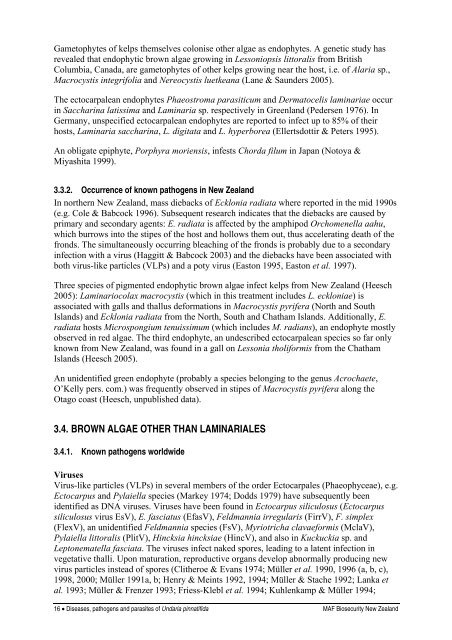Diseases, pathogens and parasites of Undaria pinnatifida
Diseases, pathogens and parasites of Undaria pinnatifida
Diseases, pathogens and parasites of Undaria pinnatifida
You also want an ePaper? Increase the reach of your titles
YUMPU automatically turns print PDFs into web optimized ePapers that Google loves.
Gametophytes <strong>of</strong> kelps themselves colonise other algae as endophytes. A genetic study has<br />
revealed that endophytic brown algae growing in Lessoniopsis littoralis from British<br />
Columbia, Canada, are gametophytes <strong>of</strong> other kelps growing near the host, i.e. <strong>of</strong> Alaria sp.,<br />
Macrocystis integrifolia <strong>and</strong> Nereocystis luetkeana (Lane & Saunders 2005).<br />
The ectocarpalean endophytes Phaeostroma parasiticum <strong>and</strong> Dermatocelis laminariae occur<br />
in Saccharina latissima <strong>and</strong> Laminaria sp. respectively in Greenl<strong>and</strong> (Pedersen 1976). In<br />
Germany, unspecified ectocarpalean endophytes are reported to infect up to 85% <strong>of</strong> their<br />
hosts, Laminaria saccharina, L. digitata <strong>and</strong> L. hyperborea (Ellertsdottir & Peters 1995).<br />
An obligate epiphyte, Porphyra moriensis, infests Chorda filum in Japan (Notoya &<br />
Miyashita 1999).<br />
3.3.2. Occurrence <strong>of</strong> known <strong>pathogens</strong> in New Zeal<strong>and</strong><br />
In northern New Zeal<strong>and</strong>, mass diebacks <strong>of</strong> Ecklonia radiata where reported in the mid 1990s<br />
(e.g. Cole & Babcock 1996). Subsequent research indicates that the diebacks are caused by<br />
primary <strong>and</strong> secondary agents: E. radiata is affected by the amphipod Orchomenella aahu,<br />
which burrows into the stipes <strong>of</strong> the host <strong>and</strong> hollows them out, thus accelerating death <strong>of</strong> the<br />
fronds. The simultaneously occurring bleaching <strong>of</strong> the fronds is probably due to a secondary<br />
infection with a virus (Haggitt & Babcock 2003) <strong>and</strong> the diebacks have been associated with<br />
both virus-like particles (VLPs) <strong>and</strong> a poty virus (Easton 1995, Easton et al. 1997).<br />
Three species <strong>of</strong> pigmented endophytic brown algae infect kelps from New Zeal<strong>and</strong> (Heesch<br />
2005): Laminariocolax macrocystis (which in this treatment includes L. eckloniae) is<br />
associated with galls <strong>and</strong> thallus deformations in Macrocystis pyrifera (North <strong>and</strong> South<br />
Isl<strong>and</strong>s) <strong>and</strong> Ecklonia radiata from the North, South <strong>and</strong> Chatham Isl<strong>and</strong>s. Additionally, E.<br />
radiata hosts Microspongium tenuissimum (which includes M. radians), an endophyte mostly<br />
observed in red algae. The third endophyte, an undescribed ectocarpalean species so far only<br />
known from New Zeal<strong>and</strong>, was found in a gall on Lessonia tholiformis from the Chatham<br />
Isl<strong>and</strong>s (Heesch 2005).<br />
An unidentified green endophyte (probably a species belonging to the genus Acrochaete,<br />
O’Kelly pers. com.) was frequently observed in stipes <strong>of</strong> Macrocystis pyrifera along the<br />
Otago coast (Heesch, unpublished data).<br />
3.4. BROWN ALGAE OTHER THAN LAMINARIALES<br />
3.4.1. Known <strong>pathogens</strong> worldwide<br />
Viruses<br />
Virus-like particles (VLPs) in several members <strong>of</strong> the order Ectocarpales (Phaeophyceae), e.g.<br />
Ectocarpus <strong>and</strong> Pylaiella species (Markey 1974; Dodds 1979) have subsequently been<br />
identified as DNA viruses. Viruses have been found in Ectocarpus siliculosus (Ectocarpus<br />
siliculosus virus EsV), E. fasciatus (EfasV), Feldmannia irregularis (FirrV), F. simplex<br />
(FlexV), an unidentified Feldmannia species (FsV), Myriotricha clavaeformis (MclaV),<br />
Pylaiella littoralis (PlitV), Hincksia hincksiae (HincV), <strong>and</strong> also in Kuckuckia sp. <strong>and</strong><br />
Leptonematella fasciata. The viruses infect naked spores, leading to a latent infection in<br />
vegetative thalli. Upon maturation, reproductive organs develop abnormally producing new<br />
virus particles instead <strong>of</strong> spores (Clitheroe & Evans 1974; Müller et al. 1990, 1996 (a, b, c),<br />
1998, 2000; Müller 1991a, b; Henry & Meints 1992, 1994; Müller & Stache 1992; Lanka et<br />
al. 1993; Müller & Frenzer 1993; Friess-Klebl et al. 1994; Kuhlenkamp & Müller 1994;<br />
16 • <strong>Diseases</strong>, <strong>pathogens</strong> <strong>and</strong> <strong>parasites</strong> <strong>of</strong> <strong>Undaria</strong> <strong>pinnatifida</strong> MAF Biosecurity New Zeal<strong>and</strong>

















